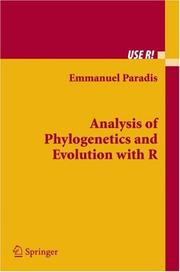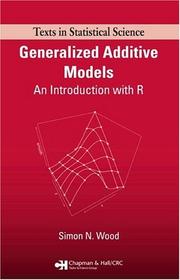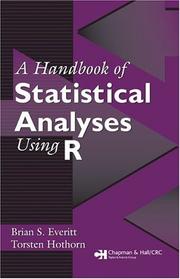| Listing 1 - 4 of 4 |
Sort by
|

ISBN: 9780387351001 0387329145 9780387329147 Year: 2006 Publisher: New York NY Springer New York
Abstract | Keywords | Export | Availability | Bookmark
 Loading...
Loading...Choose an application
- Reference Manager
- EndNote
- RefWorks (Direct export to RefWorks)
The increasing availability of molecular and genetic databases coupled with the growing power of computers gives biologists opportunities to address new issues, such as the patterns of molecular evolution, and re-assess old ones, such as the role of adaptation in species diversification. This book integrates a wide variety of data analysis methods into a single and flexible interface: the R language. This open source language is available for a wide range of computer systems and has been adopted as a computational environment by many authors of statistical software. Adopting R as a main tool for phylogenetic analyses will ease the workflow in biologists' data analyses, ensure greater scientific repeatability, and enhance the exchange of ideas and methodological developments. Graduate students and researchers in evolutionary biology can use this book as a reference for data analyses, whereas researchers in bioinformatics interested in evolutionary analyses will learn how to implement these methods in R. The book starts with a presentation of different R packages and gives a short introduction to R for phylogeneticists unfamiliar with this language. The basic phylogenetic topics are covered: manipulation of phylogenetic data, phylogeny estimation, tree drawing, phylogenetic comparative methods, and estimation of ancestral characters. The chapter on tree drawing uses R's powerful graphical environment. A section deals with the analysis of diversification with phylogenies, one of the author's favorite research topics. The last chapter is devoted to the development of phylogenetic methods with R and interfaces with other languages (C and C++). Some exercises conclude these chapters. Emmanuel Paradis is an evolutionary biologist at the Centre National de la Recherche Scientifique (CNRS) and the Institut de Recherche pour le Développement (IRD) in Montpellier. He received his Doctorate Diploma in population biology and ecology in 1993 at the University of Montpellier II. He has conducted empirical and theoretical research on birds, mammals, and fish. He worked at the British Trust for Ornithology for three years and at the Institut des Sciences de l'Évolution in Montpellier for seven years where he developed most of the ideas presented in this book. He is the main author and maintainer of the R package APE (Analysis of Phylogenetics and Evolution).
Cladistic analysis --- Phylogeny --- R (Computer program language) --- Analyse cladistique --- R (Langage de programmation) --- Methodology --- EPUB-LIV-FT LIVMATHE LIVSTATI SPRINGER-B

ISBN: 0849316227 9780849316227 9781584884866 158488486X 9781420039849 Year: 2006 Publisher: Boca Raton Taylor & Francis
Abstract | Keywords | Export | Availability | Bookmark
 Loading...
Loading...Choose an application
- Reference Manager
- EndNote
- RefWorks (Direct export to RefWorks)
Neuropathology --- Computer graphics. --- R (Computer program language) --- Infographie --- R (Langage de programmation) --- Engineering graphics --- Probability and statistics: probabilistic algorithms (including Monte Carlo);random number generation; statistical computing; statistical software (Mathematics of computing) --- 681.3*G3 Probability and statistics: probabilistic algorithms (including Monte Carlo);random number generation; statistical computing; statistical software (Mathematics of computing) --- 681.3*G3 --- Computer graphics --- 519.5 --- GNU-S (Computer program language) --- Domain-specific programming languages --- Automatic drafting --- Graphic data processing --- Graphics, Computer --- Computer art --- Graphic arts --- Electronic data processing --- Image processing --- Digital techniques --- Programming --- Artificial intelligence. Robotics. Simulation. Graphics

ISBN: 1584884746 9781584884743 Year: 2006 Publisher: Boca Raton, Fla Chapman & Hall
Abstract | Keywords | Export | Availability | Bookmark
 Loading...
Loading...Choose an application
- Reference Manager
- EndNote
- RefWorks (Direct export to RefWorks)
Now in widespread use, generalized additive models (GAMs) have evolved into a standard statistical methodology of considerable flexibility. While Hastie and Tibshirani's outstanding 1990 research monograph on GAMs is largely responsible for this, there has been a long-standing need for an accessible introductory treatment of the subject that also emphasizes recent penalized regression spline approaches to GAMs and the mixed model extensions of these models. Generalized Additive Models: An Introduction with R imparts a thorough understanding of the theory and practical applications of GAMs and related advanced models, enabling informed use of these very flexible tools. The author bases his approach on a framework of penalized regression splines, and builds a well-grounded foundation through motivating chapters on linear and generalized linear models. While firmly focused on the practical aspects of GAMs, discussions include fairly full explanations of the theory underlying the methods. Use of the freely available R software helps explain the theory and illustrates the practicalities of linear, generalized linear, and generalized additive models, as well as their mixed effect extensions.
Mathematical logic --- Mathematical statistics --- Random walks (Mathematics) --- Linear models (Statistics) --- R (Computer program language) --- 519.22 --- 512.64 --- 57.087.1 --- -519.282 --- GNU-S (Computer program language) --- Domain-specific programming languages --- Models, Linear (Statistics) --- Mathematical models --- Statistics --- Additive process (Probability theory) --- Random walk process (Mathematics) --- Walks, Random (Mathematics) --- Stochastic processes --- Mathematical models. --- Statistical theory. Statistical models. Mathematical statistics in general --- Linear and multilinear algebra. Matrix theory --- Biometry. Statistical study and treatment of biological data --- 57.087.1 Biometry. Statistical study and treatment of biological data --- 512.64 Linear and multilinear algebra. Matrix theory --- 519.22 Statistical theory. Statistical models. Mathematical statistics in general --- Linear models (Statistics). --- Random walks (Mathematics). --- Promenades aléatoires (Mathématiques) --- Modèles linéaires (Statistique) --- R (Langage de programmation) --- Modèles mathématiques --- -Mathematical models

ISBN: 1584885394 9781584885399 Year: 2006 Publisher: Boca Raton: Chapman & Hall/CRC,
Abstract | Keywords | Export | Availability | Bookmark
 Loading...
Loading...Choose an application
- Reference Manager
- EndNote
- RefWorks (Direct export to RefWorks)
Programming --- Mathematical statistics --- R (Computer program language) --- Statistique mathématique --- R (Langage de programmation) --- Data processing --- Handbooks, manuals, etc. --- Informatique --- Guides, manuels, etc. --- 681.3*G3 --- -R (Computer program language) --- -519.502855133 --- GNU-S (Computer program language) --- Domain-specific programming languages --- Mathematics --- Statistical inference --- Statistics, Mathematical --- Statistics --- Probabilities --- Sampling (Statistics) --- Probability and statistics: probabilistic algorithms (including Monte Carlo);random number generation; statistical computing; statistical software (Mathematics of computing) --- -Statistical methods --- -681.3*G3 --- 681.3*G3 Probability and statistics: probabilistic algorithms (including Monte Carlo);random number generation; statistical computing; statistical software (Mathematics of computing) --- Statistique mathématique --- 519.502855133 --- Statistical methods --- Mathematical statistics - Data processing - Handbooks, manuals, etc. --- R (Computer program language) - Handbooks, manuals, etc.
| Listing 1 - 4 of 4 |
Sort by
|

 Search
Search Feedback
Feedback About UniCat
About UniCat  Help
Help News
News